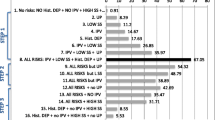Abstract
Background
Risk factors to postnatal depression (PND) have generally been identified in well-defined homogenous samples of primiparous women. There is a need for studies to assess risk factors in a heterogeneous sample of women.
Aim
This study is aimed to identify psychosocial risk factors to postnatal depression.
Method
Subjects underwent a baseline assessment within 2 days of childbirth and completed postal questionnaires at 6, 12, 18 and 24 weeks postpartum. Postnatal depression was defined as scoring above 12 on the Edinburgh Postnatal Depression Scale on two occasions and meeting criteria for major depression using the Structured Clinical Interview for DSM-III-R.
Results
Four hundred and twenty-five women with a mean age of 26.9 years participated in the study. Forty-two women were considered to be cases of postnatal depression. A significantly increased risk for postnatal depression was associated with (a) being 16 years old or younger, (b) a past history of psychiatric illness, (c) experiencing one or more life events, (d) marital dissatisfaction, (e) experiencing unsatisfactory social support, (f) a vulnerable personality and (g) having a baby of the nondesired sex.
Conclusion
This study confirmed that psychosocial risk factors, predominantly in the areas of social support and personality style, are closely associated with postnatal depression.
Similar content being viewed by others
References
Barnett B, Lockhart K, Bernard D et al (1993) Mood disorders among mothers of infants admitted to a mothercraft hospital. J Paediatr Child Health 29:270–275
Bloch M, Schmidt PJ, Danaceau M et al (2000) Effects of gonadal steroids in women with a history of postpartum depression. Am J Psychiatr 157:924–930
Boyce PM (1994) Personality dysfunction, marital problems and postnatal depression. In: Cox J, Holden J (eds) Perinatal psychiatry. Use and misuse of the Edinburgh postnatal depression scale. Gaskell, London, pp 82–102
Boyce P (2003) Risk factors for postnatal depression: a review and risk factors in Australian populations. Arch Women Ment Health 6:s43–s50
Boyce P, Stubbs J, Todd A (1993) The Edinburgh postnatal depression scale: validation for an Australian sample. Aust N Z J Psychiatry 27:472–476
Boyce P, Hickey A, Gilchrist J et al (2001) The development of a brief personality scale to measure a vulnerability to postnatal depression. Arch Women Ment Health 3:147–153
Brown GW, Harris T (1978) Social origins of depression: a study of psychiatric disorders in women. Tavistock, London
Brown GW, Harris T (1986) Stressor, vulnerability and depression: a question of replication. Psychol Med 16:739–744
Burnell I, McCarthy M, Chamberlain GVP et al (1982) Patient preference and postnatal hospital stay. J Obstet Gynaecol 3:43–47
Carty EM, Bradley CF (1990) A randomized, controlled evaluation of early postpartum hospital discharge. Birth 17:199–204
Cox JL, Holden JM, Sagovsky R (1987) Detection of postnatal depression: development of the 10-item Edinburgh postnatal depression scale. Br J Psychiatry 150:782–786
Evans J, Heron J, Francomb H et al (2001) Cohort study of depressed mood during pregnancy and after childbirth. Br Med J 323:257–260
Hickey A, Boyce P, Ellwood D et al (1997) Early discharge and risk for postnatal depression. Med J Aust 167:244–247
James ML, Hudson CN, Gebski VJ et al (1987) An evaluation of planned early postnatal transfer home with nursing support. Med J Aust 147:434–438
Murray L (1992) The impact of postnatal depression on infant development. J Child Psychol Psychiatry 33:543–561
Murray L, Carothers AD (1990) The validation of the Edinburgh post-natal depression scale on a community sample. Br J Psychiatry 157:288–290
Murray L, Cartwright W (1993) The role of obstetric factors in postpartum depression. J Reprod Infant Psychol 11:215–219
Murray L, Cooper PJ, Stein A (1991) Postnatal depression and infant development. Br Med J 302:978–979
O’Hara MW (1986) Social support, life events, and depression during pregnancy and the puerperium. AMA Arch Gen Psychiatry 43:569–573
O’Hara MW, Swain AM, (1996) Rates and risk of postpartum depression—a meta-analysis. Int Rev Psychiatry 8:37–54
O’Hara MW, Rehm LP, Campbell SB (1983) Postpartum depression: a role for social network and life stress variables. J Nerv Ment Dis 171:336–341
O’Hara MW, Neunaber J, Zekoski EM (1984) Prospective study of postpartum depression: prevalence, course and predictive factors. J Abnorm Psychology 93:158–171
O’Hara MW, Zekoski EM, Philipps LH et al (1990) Controlled prospective study of postpartum mood disorders: comparison of childbearing and nonchildbearing women. J Abnorm Psychology 99:3–15
Paykel ES, Emms EM, Fletcher J et al (1980) Life events and social support in puerperal depression. Br J Psychiatry 136:339–346
Pitt B (1968) ‘Atypical’ depression following childbirth. Br J Psychiatry 114:1325–1335
Pope S, Watts J, Evans S et al (2000) An information paper. Postnatal depression. A systematic review of published scientific literature to 1999. National Health and Medical Research Council, Canberra, Australia
Small R, Lumley J, Brown S (1992) To stay or not to stay: are fears about shorter postnatal hospital stays justified? Midwifery 8:170–177
Spitzer RL, Williams JBW, Gibbon M et al (1990) Structured Clinical Interview for DSM-III-R: SCID user’s guide for the structured clinical interview for DSM-III-R. American Psychiatric Press Inc, Washington
Tennant C, Andrews G (1976) A scale to measure the stress of life events. Aust N Z J Psychiatry 10:27–32
Uddenberg N (1974) Reproductive adaptation in mother and daughter. Acta Psychiatr Scand Suppl 254:1–115
Veiel HOF (1990) The Mannheim interview on social support: reliability and validity data from three samples. Soc Psychiatry Psychiatr Epidemiol 25:250–259
Waldenstrom U (1988) Early and late discharge after hospital birth: fatigue and emotional reactions in the postpartum period. J Psychosom Obstet Gynaecol 8:127–135
Watson JP, Elliott SA, Rugg AJ et al (1984) Psychiatric disorder in pregnancy and the first postnatal year. Br J Psychiatry 144:453–462
Webster ML, Thompson JMD, Mitchell EA et al (1994) Postnatal depression in a community cohort. Aust N Z J Psychiatry 28:42–49
Wrate RM, Rooney AC, Thomas PF et al (1985) Postnatal depression and child development: a three-year follow-up study. Br J Psychiatry 146:622–627
Author information
Authors and Affiliations
Corresponding author
Rights and permissions
About this article
Cite this article
Boyce, P., Hickey, A. Psychosocial risk factors to major depression after childbirth. Soc Psychiat Epidemiol 40, 605–612 (2005). https://doi.org/10.1007/s00127-005-0931-0
Received:
Accepted:
Published:
Issue Date:
DOI: https://doi.org/10.1007/s00127-005-0931-0




